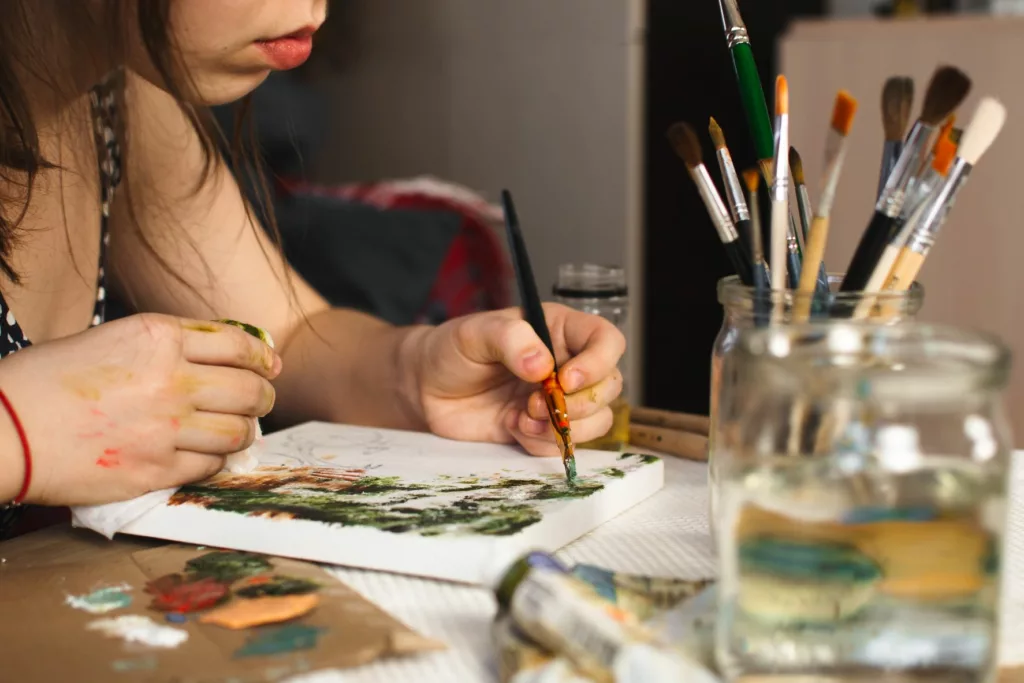Do you desire to create your own still life paintings, landscapes, portraits, abstracts, and more? Would you love to see your ideas and work born on a canvas? Well, if you do, you want to learn oil painting.
To learn any language, you must first learn the alphabet. Art is a language with its own grammar, vocabulary, and alphabet. To learn art, start with the alphabet that forms the foundation of oil painting. Basically, the techniques and rules of oil painting.
In this post, we cover the steps of how to oil paint and more.
How to Oil Paint
The following are steps for how to oil paint.
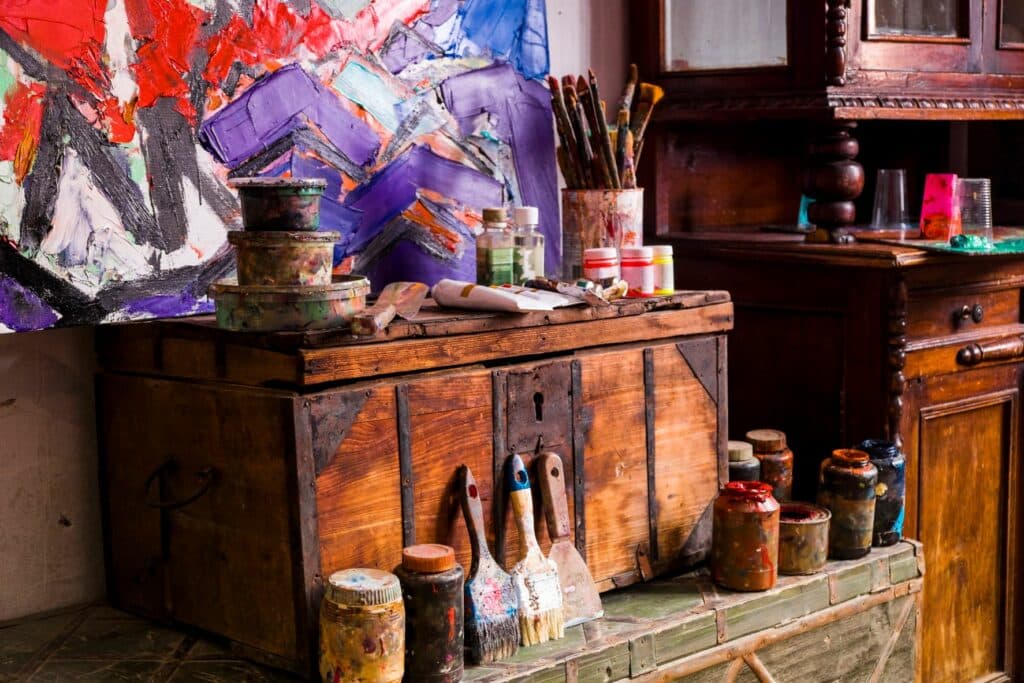
Gather Your Supplies
Your basic oil supplies should include the following items:
• An easel
• Small to large paintbrushes designed for oil painting (made from hog hair or synthetic fibers)
• A palette
• Odorless solvent
• Paper towel
• Linseed oil
• Palette knives
• Canvas
• Oil Paint cleaner
You will also need paper towels for wiping any excess paints from your brushes, and jars to hold your oil medium and solvent. I personally use old mugs to hold solvents and oil medium, but you can always go for jars. Next, you also need a charcoal pencil, coveralls, and workboots.
When shopping for oil paints start with the primary colors. Don’t forget to include black and white. Once you master the oil painting basics, you can add others.
The best oil paint for beginners is Winsor & Newton Winton Oil Color paint. Found in many art classrooms, it’s affordable and has a perfect consistency.
Set Up Your Studio
The next step is to organize your art studio at home now that you’ve the basic supplies for oil painting. The right space should be a well-lit room and ventilated in your home. If not, we recommend setting up your studio under a shady tree in your yard.
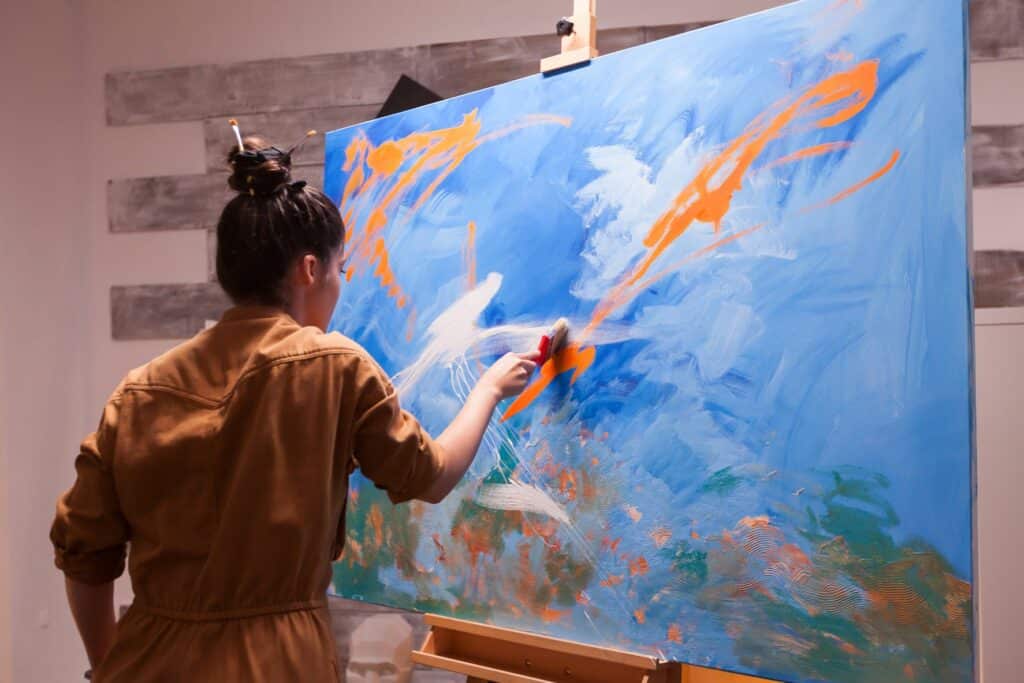
Remember, before you start painting indoors or outdoors, set up a drop cloth or old sheet over the floor or ground. The oil paints do not come off easily. By using an old sheet, you prevent any mess on your floor.
It’s a well-known fact that oil and water do not mix. This is why turpentine and solvents are a necessary evil in oil painting. Unfortunately, you have to clean your brushes after use. Since you can’t use water, we recommend that you have a solvent cleaner at hand.
Once you finish painting, wipe your brushes clean before the next session. If you get into the habit of cleaning your paintbrushes after use, they will last long and serve you for years.
Choose Your Oil Painting Surface
The beauty of oil paints is that they’re versatile. As such, you can use them on a variety of surfaces – from paper to canvas and wood. However, the canvas is the best surface for beginners as you can prime the surface all by yourself.
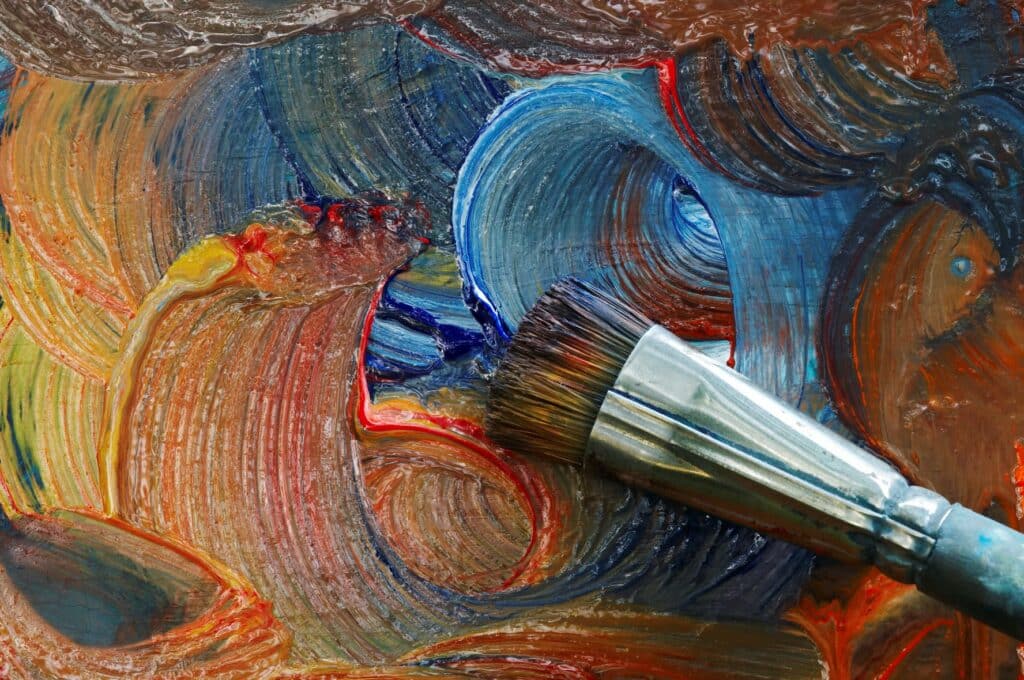
To do so, purchase a primer. The purpose of the primer is to prevent chemicals and oils in your paint from damaging the canvas. The primer also acts as a base coat. This allows your oil paints to adhere to the canvas better.
The canvas became a popular surface to paint on in the early 16th century. Prior to canvas, artists preferred wood panels. Today, you’ve the option of canvas boards and stretched canvas.
A canvas board is more sturdy and affordable than a stretched canvas. It’s composed of a canvas panel attached to a sturdy surface. The preferred sturdy surface is cardboard.
A stretched canvas panel is canvas stretched over a frame. This is the most popular option for beginners and professional painters.
Learn the Oil Painting Rules
In oil painting, a composition is usually built up using a variety of colors. For example, if painting a portrait, an artist will begin with the background color. On top of this, he will sketch the portrait with another color. Lastly, he will add more colors for details.
How the layers interact is important and they affect how your painting looks. To ensure your painting looks stunning, learn the three oil painting rules. The first rule is fat over lean. You need to make sure each successive layer is more flexible than the one underneath. You can achieve this by adding more medium to every new layer. In doing so, you stop the painting from cracking.
The second rule is thick over thin. If using a heavy color, apply thick layers over thin layers. Thin layers dry quickly. So, if using the impasto style characterized by thick, bold brush strokes, remember, thick over thin layers.
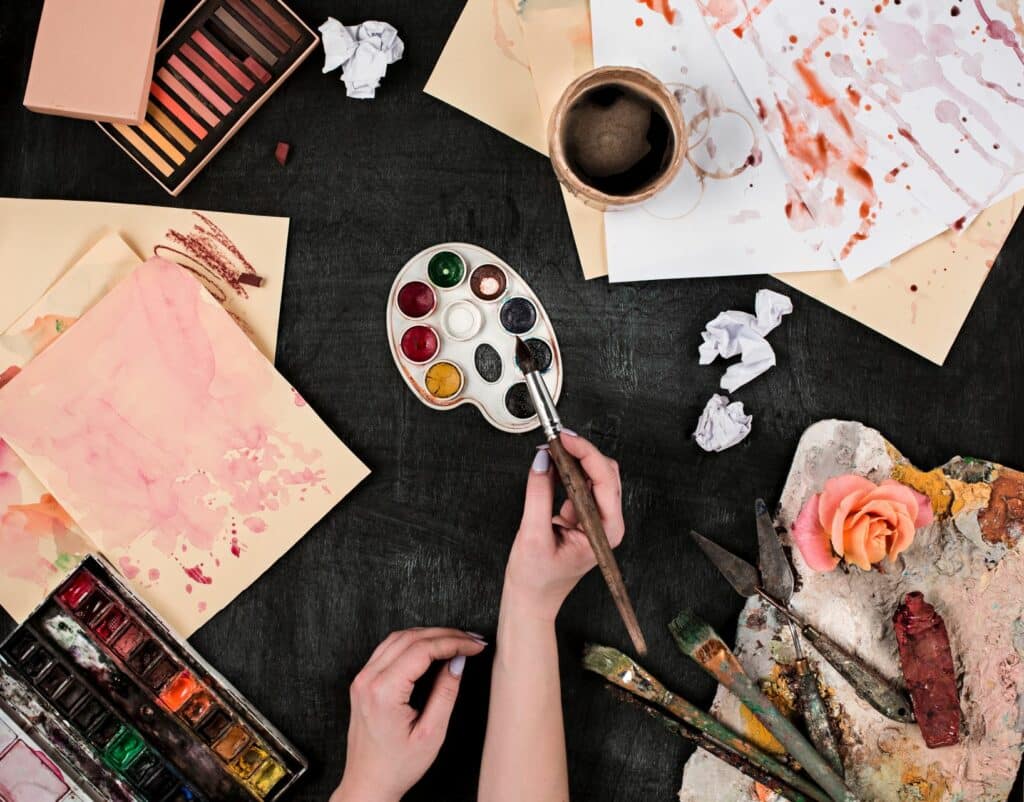
Lastly, we have slow drying over fast drying. Apply fast drying colors as under layers. Basically, apply these colors over slow-drying ones. If you apply slow drying colors over fast-drying colors, your painting will crack.
This is because the slow drying colors will take time to dry and as they dry, they will twist and pull the layers above causing cracks.
Start Your Project
The time has come for you to start your oil painting. We recommend that you start small. By doing so, you’ll find it easier to familiarize yourself with the rules of layering, the different supplies, and techniques. Try different techniques on a smaller canvas before starting a larger project.
After preparing your canvas, cover the canvas in a thin wash of the background color of your choice. Now, roughly sketch the lines, general shapes, and focal points onto the canvas. We recommend using a light coat of black paint or charcoal pencil.
Next, it’s time for you to mix the colors. As aforementioned, we recommend that you start with primary colors plus black and white. With these colors, it’s possible to mix many shades and colors. An essential tool for any beginner is the palette knife. This is ideal for mixing colors ready to paint.
You can still use the paintbrush, but a palette knife gives you a cleaner and crisper color. It also ensures that your paintbrushes do not clog up with paint. If painting an object from observation, we recommend holding the palette knife with mixed oil paint next to the object. This allows you to ensure the hue and brightness level are the same.
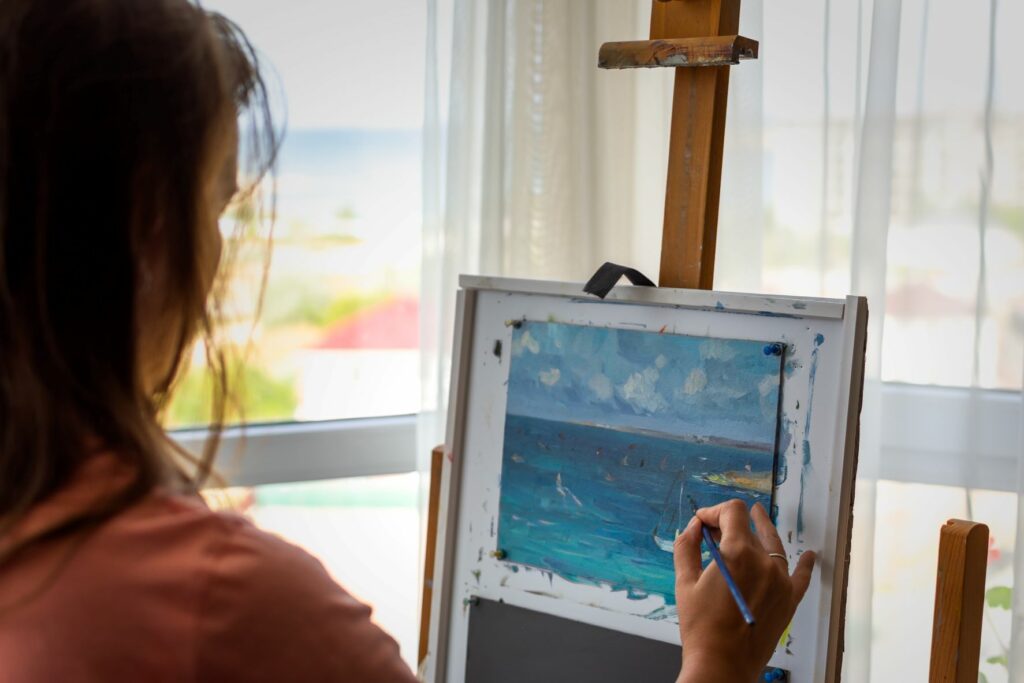
Remember, do not use this technique when comparing colors against a TV or computer screen. This is because the TV and computer screen have their lighting different from the studio lighting. To correctly mix the colors, have a color wheel available.
By now, you’ve finished your first project. As your painting dries, clean your paintbrushes. Start by wiping off the excess paint with a solvent and rag. Then, add another solvent to a cloth to remove all traces of paint. Once all the paint is gone, place the paintbrushes in a jar with the bristle end up.
Final Words
Now that you’ve finished your first oil painting, leave it on the easel for a few days. If you want to photograph the painting and share it on your social media page, wait for an overcast day. Always leave your painting to dry away from direct sunlight and dust. The tricky thing with oil paintings is that they can take up to six months for each layer to completely dry. If your oil painting is dry to the touch, use Volara tape to frame it. This will prevent the paint from sticking to the frame’s rabbet.
If you want to go beyond being just a beginner at this or any other skill, and work toward developing a real mastery, then you are going to need a deeper and more powerful strategy. What you need is a way to hack your brain so you can develop a winning mindset.
A winning mindset is a state of mind that allows you to enter a flow state at will. You do this by programming your subconscious mind.
Believe it or not, most of what you do throughout an average day is NOT freely chosen by your normal waking consciousness even though it may seem that way. The truth is that most of what you do on a day-to-day basis is done on autopilot. An example of this would be when you’re driving your car and as you do so you get bored and begin daydreaming. Before you know it, you find yourself several miles further down the road with absolutely NO memory of having driven those last several miles.
So, who exactly was driving while your waking consciousness was in la-la land, and how exactly did you manage to avoid an accident? Your subconscious mind was in control. You already spent years programming your subconscious with how to deal with a broad range of possible driving scenarios and thus it had no trouble taking the wheel while your waking consciousness took a little break. In other words, you were able to take effective actions without having to THINK about them.
The same way you programmed your subconscious to drive, you can also program it to automatically take successful actions toward mastering any other skill you decide that you want to learn. CLICK HERE to learn a proven, step-by-step formula to help you attain mastery at any skill you choose and achieve everything in life.

